CBSE Sample Papers for Class 12 Economics Paper 6 are part of CBSE Sample Papers for Class 12 Economics. Here we have given CBSE Sample Papers for Class 12 Economics Paper 6.
CBSE Sample Papers for Class 12 Economics Paper 6
| Board | CBSE |
| Class | XII |
| Subject | Economics |
| Sample Paper Set | Paper 6 |
| Category | CBSE Sample Papers |
Students who are going to appear for CBSE Class 12 Examinations are advised to practice the CBSE sample papers given here which is designed as per the latest Syllabus and marking scheme as prescribed by the CBSE is given here. Paper 6 of Solved CBSE Sample Paper for Class 12 Economics is given below with free PDF download solutions.
Time : 3 hrs
M.M.: 80
General Instructions
- All questions in both the sections A and B are compulsory. However, there is internal choice in questions of 3,4 and 6 marks.
- Question Nos. 1-4 and 13-16 are very short answer type questions, carrying 1 mark each.
They are required to be answered in one sentence each. - Question Nos. 5-6 and 17-18 are short answer I type questions, carrying 3 marks each.
Answers to them should not normally exceed 60 words each. - Question Nos. 7-9 and 19-21 are short answer II type questions, carrying 4 marks each.
Answers to them should not normally exceed 70 words each. - Question Nos. 10-12 and 22-24 are long answer type questions, carrying 6 marks each.
Answers to them should not normally exceed 100 words each. - Answers should be brief and to the point and the above word limit be adhered to as far as possible.
Section – A
Question 1.
What is the formula for computing Marginal Rate of Transformation?
Question 2.
Raj Mohan runs a clutch plate manufacturing unit and is currently operating in the second stage of law of variable proportion. State any one measure that can be adopted by him so that the transition to third stage is delayed.
Question 3.
“Total product always increases whether there is increasing returns or diminishing returns to a factor.” Is the given statement true or false? Give reason.
Question 4.
When Marginal Revenue is zero, Total Revenue is
(a) increasing
(b) diminishing
(c) maximum
(d) minimum
Question 5.
Briefly discuss the causes of economic problem.
Or
Diagrammatically illustrate the impact of import substitution policy on the Production Possibility Curve (PPC) of India.
Question 6.
Given below is the utility schedule of a consumer for commodity X. The price of the commodity is ₹ 6 per unit. How many units should the consumer purchase to maximise satisfaction? (Assume that the utility is expressed in utils and 1 util = ₹ 1).
| Consumption (units) | Total Utility (utils) | Marginal Utility (utils) |
| 1 | 10 | 10 |
| 2 | 18 | 8 |
| 3 | 25 | 7 |
| 4 | 31 | 6 |
| 5 | 34 | 3 |
| 6 | 34 | 0 |
Question 7.
Explain the effect of the following on elasticity of supply of the good :
(i) Nature of inputs used
(ii) Technique of production
Or
Distinguish between short-run and long-run production functions.
Question 8.
When the price of a commodity goes up by 10%, a consumer’s demand falls from 500 units to 400 units. Calculate the Price Elasticity of Demand (Ed).
Question 9.
Explain the implications of the following features of perfect competition.
(i) Large number of buyers and sellers.
(ii) Freedom of entry and exit of the firm.
Question 10.
How is equilibrium price determined? How is it affected by changes in demand for the commodity?
Question 11.
What is meant by price elasticity of demand? Explain briefly any five factors affecting elasticity of demand.
Or
Why is a consumer in equilibrium, only at the point of tangency of the budget line with an indifference curve?
Question 12.
State whether the following statements are true or false. Give reasons for your answer.
(i) When Marginal Revenue (MR) is constant and not equal to zero, then Total Revenue (TR) will also be constant.
(ii) As soon as Marginal Cost (MC) starts rising, Average Variable Cost (AVC) also starts rising.
(iii) Marginal Product (MP) starts diminishing from the point of inflexion.
Section B
Question 13.
What is capital expenditure in the government budget?
Question 14.
Which of these is not an example of direct tax?
(a) Wealth tax
(b) Income tax
(c) Sales tax
(d) Corporation tax
Question 15.
The total deposits of commercial banks are ₹ 1,00,000 crore, while the money created by commercial banks is ₹ 50,00,000 crore. Find the value of Legal Reserve Ratio.
Question 16.
What are the components of measurement of money supply?
Question 17.
“Country ‘Z’ is operating at full employment equilibrium.” What are the implications of this statement? Identify the economic value being followed by the country.
Question 18.
Investment demand includes financial investment like purchase of shares from secondary market. Do you agree?
Or
Explain consumption function with the help of a diagram.
Question 19.
If the real GDP is ₹ 3,000 and price index is 175, then calculate the nominal GDP. What does the price index of 175 indicate?
Question 20.
Explain the problem of double coincidence of wants faced under Barter System. How money has solved this problem?
Or
Describe the evolution of money.
Question 21.
Government has started spending more on providing free services like education and health to the poor. Explain the economic value it reflects.
Question 22.
Calculate Gross National Product at Factor Cost by
(i) Income method and
(ii) Expenditure method from the following data.
| S. No. | Contents | (₹) in crores |
| (i) | Net Domestic Capital Formation | 500 |
| (ii) | Compensation of Employees | 1,850 |
| (iii) | Consumption of Fixed Capital | 100 |
| (iv) | Government Final Consumption Expenditure | 1,100 |
| (V) | Private Final Consumption Expenditure | 2,600 |
| (Vi) | Rent | 400 |
| (vii) | Dividend | 200 |
| (viii) | Interest | 500 |
| (ix) | Net Exports | (-)100 |
| (X) | Profits | 1,100 |
| (xi) | Net Factor Income from Abroad | (-)50 |
| (xii) | Net Indirect Taxes | 250 |
Identify the economic value involved in the estimation of national income.
Question 23.
Given below is the Consumption Function (C) in an economy.
C = 200 + Y
With the help of a numerical example, show that in this economy, as income increases Average Propensity to Consume (APC) will decrease.
Or
The savings function of an economy is S = – 200 + Y. The economy is in equilibrium when income is equal to ₹ 2,000. Calculate
(i) Investment Expenditure at Equilibrium Level of Income (I)
(ii) Autonomous Consumption (\(\overline { C } \))
(iii) Investment Multiplier (K)
Question 24.
(i) Other thing? remaining constant, explain the impact of rise in foreign currency on national income.
(ii) Give any three points of difference between depreciation of currency and devaluation of currency.
Answers
Answer 1.
Marginal Rate of Transformation
\(=\frac { Units\quad of\quad Good\quad Y\quad Sacrified\quad \left( \triangle Y \right) }{ Units\quad od\quad Good\quad X\quad Gained\quad \left( \triangle X \right) } \)
Answer 2.
By improving the technology of production, Raj Mohan can delay the transition to the third state of law of variable proportion.
Answer 3.
The given statement is true. In stages of increasing and diminishing returns, total product rises because in these stages marginal product is positive.
Answer 4.
(c) Maximum
Answer 5.
Economic problem arises due to the following reasons :
- Human “Wants are Unlimited Human wants are unlimited as it is a repetitive process in which wants get increased by consuming goods and sen/ices. Fulfillment of one want leads to the surfacement of another want.
- Resources are Limited Resources are limited in supply in relation to their demand. Scarcity is the basic feature of every economy. No economy can be self-sufficient in everything. Scarcity is a universal phenomenon, which continues indefinitely. The scarcity of resources creates economic problem for every country in the world.
- Resources have Alternative Uses The resources are not only scarce in supply but they also have alternative uses. e.g. land can be used to produce wheat or to rice or to build a hospital or a school. A choice between the alternative uses of land has to be made. This problem of choice leads to an economic problem.
Or
Import substitution policy means producing goods in the country rather than importing from rest of the world. To produce more output, now inputs are being imported which increases the resources of the country. Consequently, production possibility curve would shift right from ab to a1b1.
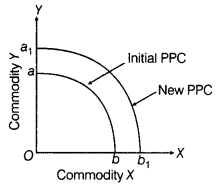
Answer 6.
The consumer will purchase 4 units because at this consumption level, Marginal Utility (MU) is equal to the price. At consumption level of less than 4 units, MU is greater than price. Therefore, there is a scope of increasing gain by purchasing more. If he buys more than 4 units, MU becomes less than the price. Therefore, there is a scope of increasing gain by purchasing less, so consumer maximises satisfaction at 4 units of consumption of commodity X.
Answer 7.
The effect of the following on elasticity of supply of the good is as follows:
- Nature of Inputs Used The Elasticity of Supply depends on the nature of inputs used for the production of a commodity. If commonly available inputs are used, supply will be elastic, but in case of scarcely available inputs, the supply will be inelastic.
- Technique of Production In case of production of a commodity, supply will be less elastic if it involves the use of a complex and expensive technology. On the other hand, use of a simple technology facilitates quicker changes in output and supply.
Or
Difference between short-run production function and long-run production function are:
| Basis | Short-run Production Function | Long-run Production Function |
| Nature of factors | Some factors are variable while ” others are fixed. | All factors are variable. |
| Proportions type | Short-period production function is of variable proportions type. | Long-period production function is of constant proportions type. |
| Scale of output | Scale of output remains constant. | Scale of output changes. |
| Study of output behaviour | Behaviour of output is studied with reference to ‘Returns to a factor’ or ‘Law of Variable Proportions. | Behaviour of output is studied with reference to ‘Returns to scale’. |
Answer 8.
Given, Percentage change in price = 10%,
Initial Quantity (Q) = 500 units
New Quantity = 400 units
Change in Quantity (∆Q) = 400 – 500 = -100 units
Percentage change in quantity demanded
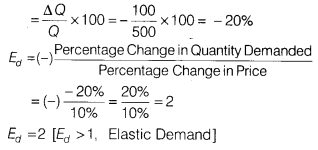
Answer 9.
(i) Very Large Number of Buyers and Sellers A perfectly competitive market is dominated by very large number of buyers and sellers of a commodity. It means that there is no such buyer or seller in the market whose purchase or sale is so large as to impact the total sale or purchase in the market. Each buyer and seller has only a fractional share in the market demand and market supply respectively. Each buyer and seller has to accept the price as it is in the .market. Therefore, it is said that a firm under perfect competition is a price taker not a price maker.
(ii) Freedom of Entry and Exit of Firm Under perfect competition, a firm can enter or leave the industry anytime. In order to analyse the implications of this feature, we need to focus on short period and long period situation. Short period by definition, is too short for an existing firm to leave the industry or for a new firm to join the industry. Accordingly, the significance of this feature is restricted only to long period situations. Because of free entry and exit, firms in the long-run earn only normal profits. In case, extra normal profits are earned, new firms will join the industry. In this case, market supply will increase, market price will fall and extra normal profits will be wiped out. In case of extra normal losses, some of the existing firms will leave the industry. Market supply will decrease, market price will increase and extra normal losses will be wiped out. Hence, there will be neither supernormal profits nor losses in the long-run.
Answer 10.
Equilibrium price is determined at a point where market demand is equal to market supply. Other things being equal, equilibrium price increases with an increase in demand and falls with a decrease in demand as shown in the following figure:
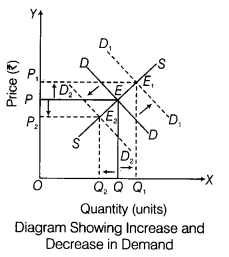
In the given figure, DD is the initial demand curve and SS is the supply curve. Initially, the equilibrium point is E. Corresponding to this point, equilibrium price is OP.
As demand increases, demand curve DD shifts rightwards to D1D1. Supply remaining the same, equilibrium point shifts to E1. At this point, the equilibrium price is OP1. which is higher than OP. As demand decreases, demand curve DD shifts leftwards to D2D2. Supply remaining the same, equilibrium point shifts to E2. At this point, the equilibrium price is OP2, which is lower than OP.
Answer 11.
Price elasticity of demand measures the degree of responsiveness of quantity demanded of a commodity to a change in its price. Price Elasticity of Demand for a commodity is defined as the percentage change in quantity demanded for the commodity divided by the percentage change in its price.
Some of the important determinants of price elasticity of demand are as follows: (any five)
- Nature of the Commodity Nature of the commodity is an important determinant of the price Elasticity of Demand. Necessities like food items and prestige goods have an inelastic demand, while luxuries and comforts have comparatively elastic demand.
- Availability of Substitutes The demand for commodities having close substitutes is very elastic because if there is an increase in the price of the commodity, their people will start using substitute commodities.
- Postponement of Consumption The demand for commodities is elastic, whose consumption can be postponed for sometime such as the demand of television, otherwise it is inelastic as in the case of medicines.
- Different Uses of the Commodity A commodity which has several uses will have an elastic demand. On the other hand, a commodity having only one use will have inelastic demand, e.g. milk, steel, etc have elastic demand because they can be put to several uses.
- Time Period Generally, longer the duration of period, greater will be the elasticity of demand because consumer have enough time to adjust their demand and vice-versa.
- Habits If consumers are habituated of some commodities, the demand for such commodities will usually be inelastic, e.g. alcohol.
- Proportion of Income Spent on the Goods Items such as toothpaste, needle will have an inelastic demand as consumers spend a small proportion of their income on such items. On the other hand, goods on which the consumers spend a large proportion of their income (cloth, food, etc) tend to have elastic demand.
Or
Consumer’s equilibrium is a point where budget line is tangent to Indifference Curve (IC) or equilibrium is achieved where slope of Indifference Curve is equal to the slope of budget line or price line.
Two conditions of the consumer’s equilibrium are given below:
(i) \(XY=\frac { { P }_{ X } }{ { P }_{ Y } } \)
(ii) At the point of equilibrium, Indifference Curve must be convex to the origin. It implies that at the point of equilibrium, MRS must be diminishing.
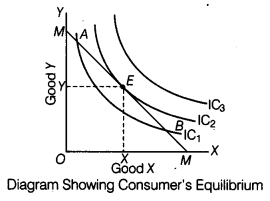
In the given diagram, E is the equilibrium point at which budget line touches the higher Indifference Curve IC2. Points ’A’ and ‘B’ lie on IC1, which offers lower level of satisfaction to the consumer and IC3 is not affordable as per the income of consumer and prices of the two goods.
So, the consumer is at equilibrium at point F’ only, where the indifference curve is tanget to the budget line.MM.
Answer 12.
- False, because when Marginal Revenue (MR) is constant, Total Revenue (TR) is increasing at a constant rate. Only when Marginal Revenue is zero, Total Revenue is constant.
- False, Average Variable Cost (AVC) can fall even when Marginal Cost (MC) starts rising. In the figure given, MC is at its minimum at point ‘a’ and AVC is at its minimum at point Between points ‘a’ to ‘b’, MC is rising, but AVC is falling.
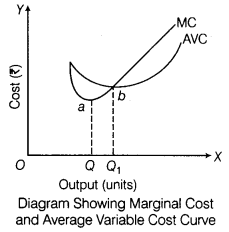
- True, because point of inflexion is a point from where slope of Total Product (TP) changes. And, Slope of TP=MP. Therefore, from this point, MP stops increasing and starts diminishing.
Answer 13.
Capital expenditure of the government budget refers to those expenditures of the government which either increase assets or reduce liabilities of the government.
Answer 14.
(c) Sales tax because it is not levied directly on the income of the consumer or earner.
Answer 15.
We know that,
Money created
= Deposits of Commercial Banks x \(\frac { 1 }{ LRR } \)
\(50,00,000=1,00,000\times \frac { 1 }{ LRR } \)
⇒ \(LRR=\frac { 1 }{ 50,00,000 } \) = 0.02 or 2%
Answer 16.
The components of M1 measurement of money supply (M1)=Currency (including notes and coins held by people) + Demand Deposits + Other Demand Deposits
Answer 17.
The implications of this statement are as follows:
- Aggregate demand is equal to aggregate supply in country ‘Z’.
- In country ’Z’, resources are being utilised in an optimum manner.
Economic value being followed is that of best use of country’s resources.
Answer 18.
No, I do not agree. The term investment demand refers to the demand for real investment and not financial investment. Real investment is concerned with the increase in stock of capital assets such as tools, equipments, inventories and also increase in stock of consumer goods. Thus, it does not include investment in shares and securities.
Or
The functional relationship between the consumption expenditure and the income is known as consumption function. Symbolically,
C = f (Y), which is read as, ‘Consumption is a function of income’.
Consumption function in terms of an algebric expression can be written as:
\(C=\overline { C } +bY\)
Where, C = Consumption expenditure
\(\overline { C } \) = Autonomous consumption at zero level of income
b = Marginal Propensity to Consume
Y = Income
Let us understand it with the help of a diagram.
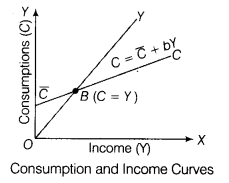
In the above diagram, point B represents the break-even point, where the consumption expenditure is equal to the income. To the left of point S, consumption is greater than income and to the right of point 6, consumption is less than income.
Answer 19.
Given,
Real Gross Domestic Product = ₹ 3,000, and Price Index = 175
We know that,
Price Index = \(\frac { Nominal\quad GDP }{ Real\quad GDP } \times 100\)
\(\Rightarrow 175=\frac { Nominal\quad GDP }{ 3,000 } \times 100\)
Norminal GDP = 175 x 30
=₹ 5,250
The price index of 175 indicates that as compared to the base year, the prices have increased by 75%. in current year
Answer 20.
Double Coincidence of Wants Barter system can only work, when both the persons are ready to exchange each other’s goods. For example, if a person has surplus rice and he wants wheat then he will have to find a person who has surplus wheat and wants rice. But usually this type of double coincidence is rare, especially in modern times.
Money has eliminated double coincidence of wants. In modern times, the buyer buys goods for money and the seller sells goods for money. So, the person having surplus rice can sell it in the market for money and from that money he can purchase wheat. So, money facilitates exchange of goods and services and helps in carrying on trade smoothly.
Or
The various forms that money took during the process of evolution are discussed below:
- Commodity Money All sorts of commodities like pearls, sea-shells, salt etc have been used as a medium of exchange.
- Animal Money Animals such as cow, goat, etc were used as a medium of exchange. .
- Metallic Money Money made from metals like gold, silver, copper etc was called metallic money.
- Paper Money Money made of paper is known as paper money.
- Credit Money It refers to bank deposits with banks which are withdrawable through a cheque.
- Plastic Money It is the modern form of money in the form of debit and credit cards.
- Virtual Money It is the latest form of money which exists in web world. Bit coin is the example of virtual’money.
Answer 21.
With the efforts of government in raising educational and health related services, level of health and education of poor people is expected to rise. This leads to a rise in human capital formation.
Efficiency of workers is expected to rise with improvement in their health and with improvement in their education, skill formation will take place.
Consequently, the level of technology tends to scale up due to which more research and innovations are facilitated.
Higher level of output is achieved with the same level of inputs. So, Production Possibility Curve (PPC) tends to shift to the right.
Answer 22.
(i) By Income Method
Gross National Product at Factor Cost = Compensation of Employees + Rent + Interest + Profits ‘ + Net Factor Income from Abroad + Consumption of Fixed Capital
= 1,850 + 400 + 500 + 1,100 + (- 50) + 100
= 3,950 – 50 = ₹ 3,900 crore
(ii) By Expenditure Method
Gross National Product at Factor Cost = Private Final Consumption Expenditure + Government Final Consumption Expenditure + Net Domestic Capital Formation + Consumption of Fixed Capital + Net Exports + Net Factor Income from Abroad – Net Indirect Taxes
= 2,600 + 1,100+ 500 + 100 + (-100) + (-50) – 250
= 4,300 – 400 = ₹ 3,900 crore
The economic value involved in estimation of national income is to assess the level of economic development in the country.
Answer 23.
Consumption Function (C) =200 + 0.75 Y
Suppose, Income (Y) in the economy is ₹ 400, ₹ 500 or ₹ 600
When Y = 400
C= 200 + 0.75 x 400 = ₹ 500
When, Y = 500
C= 200 + 0.75 x 500 = ₹ 575
When Y = 600
C= 200 + 0.75 x 600 = ₹ 650
Therefore,
| Income (Y) | Consumption (C) | APC (C /Y) |
| 400 | 500 | 500/400 = 1.25 |
| 500 | 575 | 575/500 = 1.15 |
| 600 | 650 | 650/600 = 1.08 |
From the above table, it is clear that as income rises, Average Propensity to Consume (APC) decreases.
Therefore, as shown in the given example as income increases from ₹ 400 to ₹ 500 to ₹ 600,
APC decreases from 1.25 to 1.15 to 1.08, respectively.
Or
(i) Investment Expenditure Substituting the value of
Y in saving function,
We get
S = -200+ 0.25 x 2,000 = ₹ 300
At equilibrium level of income, S = /
So, / =₹ 300
Thus, investment expenditure at equilibrium level of income is ₹ 300.
where, S = Savings
/ = Investments, Y = National Income/Income
(ii) Autonomous Consumption
Consumption + Saving = Income … (i)
Autonomous consumption refers to that level of consumption expenditure where income is zero. Flere, if income (Y) = 0, Saving (S) = -200 Putting these value in equation (i), We get Consumption + (- 200) = 0
⇒ Consumption = ₹ 200 So, Autonomous Consumption = ₹ 200
(iii) investment Multiplier \(K=\frac { 1 }{ MPS } \)
From saving function, we know that
Marginal Propensity to Save (MPS) = 025
Investment Multiplier (K) = \(\frac { 1 }{ 0.25 } =4\)
Answer 24.
(i) There is no direct impact on national income of a country with change in exchange rate. But change in exchange rate has an indirect impact on national income. When exchange rate rises, domestic currency depreciates. The foreign countries can now purchase more quantity of goods and services from the same amount of foreign currency from the domestic country. Imports tends to fall and exports tend to rise. Accordingly, aggregate demand tends to rise. A rise in AD may lead to a rise in national income.
(ii) Difference between depreciation and devaluation of currency are:
| Basis | Depreciation of Currency | Devaluation of Currency |
| Market forces of demand and supply | Depreciation of foreign currency is determined by market forces of demand and supply. | Devaluation of foreign currency is not determined by market forces of demand and supply. |
| Government intervention | There is generally no direct intervention of government. | Devaluation is generally done by government itself. |
| Planning | It is not planned at all. | It is generally planned by government. |
We hope the CBSE Sample Papers for Class 12 Economics Paper 6 help you. If you have any query regarding CBSE Sample Papers for Class 12 Economics Paper 6, drop a comment below and we will get back to you at the earliest.